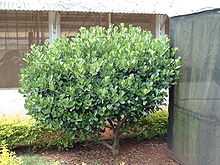Clusia
| Clusia | |
|---|---|
 | |
| Clusia fluminensis | |
| Scientific classification | |
| Kingdom: | Plantae |
| (unranked): | Angiosperms |
| (unranked): | Eudicots |
| (unranked): | Rosids |
| Order: | Malpighiales |
| Family: | Clusiaceae |
| Subfamily: | Clusioideae |
| Tribe: | Clusieae |
| Genus: | Clusia L. |
| Species | |
|
Around 145, see text | |
| Synonyms | |
|
Androstylium Miq. | |

Clusia is the type genus of the family Clusiaceae. Comprising 300-400 species, it is native to tropical America. The genus Clusia is named in honor of the botanist Carolus Clusius.
Description
Its species are shrubs, vines and small to medium-size trees up to 20 m tall, with evergreen foliage. Some species start life as epiphytes, then develop long roots that descend to the ground and eventually strangle and kill the host tree in a manner similar to strangler figs.
The leaves are opposite, 5–20 cm long and 2–10 cm broad, with a leathery texture and an entire margin. The flowers are white, cream, yellow, pink, red, blackish or green with 4-9 petals. The fruit is a leathery valvate capsule which splits open to release several red or orange, fleshy-coated seeds.
Clusia plants provide excellent nesting sites for some insects. For instance, Clusia grandiflora, a common species in Guianese forests, is an attractive place for Polistes pacificus wasps to build their paper nests because arboreal ants, which often prey on these wasps, do not normally reside in this species of tree.[1]
Selected species
- Clusia alata
- Clusia arborea
- Clusia carinata
- Clusia clarendonensis
- Clusia clusioides
- Clusia croatii
- Clusia cupulata
- Clusia fluminensis Planch. & Triana
- Clusia guttifera
- clusia grandiflora
- Clusia lanceolata
- Clusia longipetiolata
- Clusia major – Copey, Autograph Tree, Pitch-apple
- Clusia minutiflora
- Clusia osseocarpa
- Clusia palmicida
- Clusia plurivalvis
- Clusia polystigma
- Clusia portlandiana
- Clusia pseudomangle
- Clusia rosea – Scotch attorney, Autograph Tree, Pitch-apple
- Clusia skotaster
- Clusia spiritu-sanctensis
- Clusia tarmensis
- Clusia uvitana
- Clusia valerioi
Gallery
-
-_leaf_with_autograph%2C_flower%2C_fresh_fruit%2C_and_dried_fruit.jpg)
Autograph tree (C. rosea): leaf with autograph, flower, fresh fruit, and dried fruit.
-

Clusia lanceolata, Fairchild Tropical Botanic Garden
References
- ↑ Corbara, Bruno et al. (2009). "Diversity and nest site selection of social wasps along Guianese forest edges: assessing the influence of arboreal ants". C.r. Biologies 332:470-479.
External links
![]() Media related to Clusia at Wikimedia Commons
Media related to Clusia at Wikimedia Commons
- Clusia rosea photos
- Key to Clusia species from Brazil (Portuguese)